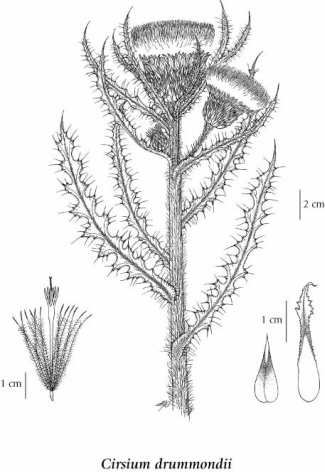Drummond's thistle (dwarf thistle)
Asteraceae (Aster family)
Introduction to Vascular Plants
Species Information
General:
Biennial herb from a taproot; stems erect, branched, thick, fleshy, woolly-hairy, simple, 1.2-3.0 m tall.
Leaves:
Basal and stem leaves narrowly oblanceolate to lanceolate, lobed 1/2 or 3/4 the width of the blade, segments oblong-triangular, margins of the segments with 3-5 slender spines, the upper surface glabrous to soft-hairy, the lower surface unevenly hairy, the uppermost leaves narrower, ascending, extending beyond the compact group of heads.
Flowers:
Heads discoid, 1-9, in a terminal cluster; involucres egg-shaped, 3-5 cm tall; involucral bracts glabrous, glandular, graduated, outer ones egg-shaped, tapering to a stout, 2-3 mm spine, inner ones progressively narrower with a broadly dilated, papery, irregularly-margined tip; disk flowers purplish-red, 30-44 mm long, the tubes 20-30 mm long, the lobes 5-7 mm long.
Fruits:
Achenes 4-5.5 mm long, straw-coloured with a light apical rim; pappus whitish, becoming yellowish at maturity, shorter than the corollas by 1-8 mm.
Illustration

If more than one illustration is available for a species (e.g., separate illustrations were provided for two subspecies) then links to the separate images will be provided below. Note that individual subspecies or varietal illustrations are not always available.
Illustration Source: The Illustrated Flora of British Columbia
Habitat and Range
Mesic to dry roadsides, meadows and forest openings in the steppe and lower montane zones; frequent in SC and SE BC, rare in the Peace River area; E to ON and S to WY.Status Information
Synonyms
Synonyms and Alternate Names:
Cirsium coccinatum Osterh.
Taxonomic Keys
TAXONOMIC KEY TO CIRSIUM
1. Heads small; involucres 1-2 (rarely 2.5) cm tall; plants introduced.
2. Stems distinctly spiny-winged; plants with perfect flowers C. palustre 1. Heads large; involucres more than 2 cm tall; plants native (except C. vulgare).
3. Leaves bristly-spiny above, stems distinctly spiny-winged............ C. vulgare
4. Pappus of mature seeds exceeding the corollas by 1-10 mm.............. C. foliosum
5. Heads large; involucres 3-5 cm tall........... C. drummondii 6. Outer involucral bracts more than 2 mm wide at base, slightly if at all hairy and if so, then mainly marginal.
7. Outer involucral bracts strongly glandular; lowermost leaves deeply pinnately lobed more than 1/2 the width of the blade.............. C. undulatum 6. Outer involucral bracts less than 2 mm wide at base, densely cobwebby.
8. Corollas white or creamy-white, rarely pinkish; involucral bracts greenish............. C. hookerianum
9. Styles exceeding the corollas by at least 3 mm; achenes 5-6.5 mm long; leaves usually lobed more than 1/2 the width of the blade.............. C. edule Source: Illustrated Flora of British Columbia |